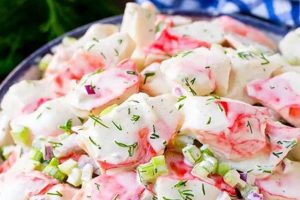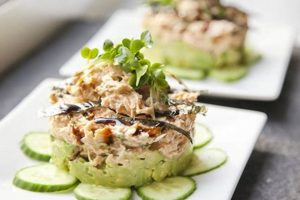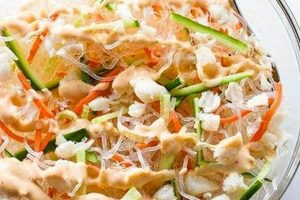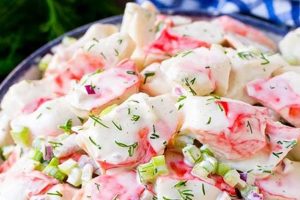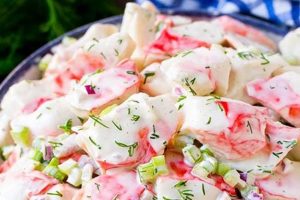A refreshing and light dish, typically composed of cooked and chilled shellfish like crab and shrimp, combined with complementary ingredients. These often include mayonnaise or a lighter vinaigrette, along with celery, onion, herbs, and seasonings. Variations might incorporate other seafood, vegetables, or fruits for added flavor and texture. This type of salad can be served as a standalone meal, a starter, or part of a larger buffet spread.
Seafood salads offer a nutritious and flavorful way to enjoy the benefits of omega-3 fatty acids and lean protein. Historically, combining readily available fresh seafood with simple ingredients has been a culinary practice across various cultures. From coastal communities to inland areas with access to fresh catches, the adaptable nature of these salads allows for variations based on regional preferences and available ingredients. This flexibility has contributed to the enduring popularity of these dishes. They present a convenient and appealing way to incorporate seafood into a balanced diet, particularly during warmer months.
The following sections will delve into specific recipe variations, explore optimal ingredient selection, and provide guidance on safe handling and preparation techniques for crafting a delicious and healthy seafood salad.
Tips for a Superior Seafood Salad
Creating a truly exceptional seafood salad requires attention to detail and an understanding of key principles. The following tips offer guidance for achieving optimal flavor, texture, and food safety.
Tip 1: Ingredient Quality is Paramount: Opt for the freshest seafood available. High-quality crabmeat and shrimp are essential for both flavor and safety. Look for firm, intact pieces with a fresh, ocean-like scent. Avoid seafood with a strong fishy odor or slimy texture.
Tip 2: Proper Thawing Techniques: Thaw frozen seafood slowly and safely in the refrigerator, never at room temperature. Rapid thawing can compromise texture and increase the risk of bacterial growth.
Tip 3: Gentle Handling Preserves Texture: Avoid overmixing or handling the seafood roughly. Delicate crabmeat can easily break apart, resulting in a less appealing final product.
Tip 4: Balance Flavors Carefully: The dressing should complement, not overwhelm, the delicate flavor of the seafood. A simple vinaigrette or a light mayonnaise-based dressing often works best. Seasoning should be judicious, allowing the natural flavors of the crab and shrimp to shine through.
Tip 5: Enhance with Fresh Herbs and Vegetables: Finely diced celery, red onion, and fresh herbs like dill, parsley, or chives add brightness and complexity. Consider incorporating other vegetables for added texture and flavor, such as bell peppers or finely chopped cucumbers.
Tip 6: Chill Thoroughly Before Serving: Chilling allows the flavors to meld and enhances the refreshing quality of the salad. Aim for at least 30 minutes of refrigeration before serving.
Tip 7: Mindful Presentation Enhances Enjoyment: Consider serving the salad on a bed of lettuce, in individual cups, or as a filling for sandwiches or wraps. Garnishing with fresh herbs or a sprinkle of paprika can elevate the visual appeal.
By following these tips, one can achieve a seafood salad that is not only delicious but also showcases the inherent qualities of fresh, high-quality ingredients. Attention to detail, from ingredient selection to presentation, ensures a memorable culinary experience.
This understanding of the key elements of a successful seafood salad preparation provides a solid foundation for exploring more complex variations and developing one’s own signature recipes.
1. Fresh, High-Quality Ingredients
The success of a simple seafood salad hinges directly on the quality of its core components. Fresh, high-quality ingredients are not merely desirable; they are fundamental to achieving the desired flavor profile, texture, and overall culinary experience. Subpar ingredients can compromise the dish, resulting in a bland, unappetizing, or even unsafe outcome. This section explores the critical role of ingredient quality in crafting a truly exceptional seafood salad.
- Seafood Selection:
The foundation of any seafood salad lies in the seafood itself. Fresh crabmeat should exhibit a delicate, sweet flavor and a firm, flaky texture. Shrimp should be plump, firm, and have a clean, briny aroma. Avoid seafood with a strong fishy odor, discoloration, or a slimy texture. Sourcing seafood from reputable suppliers who prioritize sustainable fishing practices ensures both quality and responsible consumption. Opting for previously frozen seafood can be a viable option if fresh is unavailable, but proper thawing techniques are essential for preserving texture and minimizing bacterial growth.
- Produce Quality:
Fresh produce provides crucial textural and flavor contrasts to the seafood. Crisp celery and finely diced red onion offer a refreshing crunch, while herbs like dill, parsley, and chives contribute aromatic complexity. Select produce that is vibrant in color, firm to the touch, and free from blemishes. Washing and properly storing produce maintains freshness and extends shelf life.
- Dressing Considerations:
The dressing serves as a unifying element, binding the ingredients and enhancing their flavors. A simple vinaigrette made with high-quality olive oil, lemon juice, and seasonings can provide a light and refreshing complement to the seafood. Alternatively, a mayonnaise-based dressing, if chosen, should be made with fresh ingredients and used sparingly to avoid overpowering the delicate flavors of the crab and shrimp.
- Seasoning and Flavor Enhancements:
Proper seasoning elevates the natural flavors of the ingredients. A judicious use of sea salt, freshly ground black pepper, and a touch of lemon zest can brighten the overall flavor profile. Other seasonings, such as paprika or Old Bay, can be used sparingly to add depth and complexity. However, it’s essential to avoid over-seasoning, which can mask the delicate flavors of the seafood.
The emphasis on fresh, high-quality ingredients is integral to achieving a simple yet elegant seafood salad. By prioritizing ingredient selection and understanding the interplay of flavors and textures, one can create a dish that showcases the inherent quality of the components and provides a truly satisfying culinary experience.
2. Proper Seafood Handling
Proper seafood handling is paramount in a simple seafood salad recipe featuring crabmeat and shrimp. This meticulous approach directly impacts not only the final dish’s safety but also its flavor and texture. Mishandling seafood introduces risks of bacterial contamination, leading to foodborne illnesses. Moreover, improper thawing or storage can compromise the delicate textures of crab and shrimp, rendering them mushy or unappetizing. For example, thawing shrimp at room temperature encourages rapid bacterial growth, while overcooking toughens the protein, resulting in a rubbery texture. Conversely, maintaining appropriate cold chain management from purchase to preparation preserves the seafood’s integrity and minimizes risks.
The practical significance of proper seafood handling becomes evident in the final product. A salad made with carefully handled seafood showcases the natural sweetness and delicate textures of crab and shrimp. The flavors are clean and bright, unmarred by off-putting tastes or aromas that indicate spoilage. This careful attention translates to a more enjoyable and safe dining experience. Consider the difference between succulent, chilled shrimp in a salad versus shrimp that is tough and carries a faint ammonia odorthe former exemplifies proper handling, while the latter indicates mishandling. Therefore, adhering to safe handling practices becomes an integral part of the recipe itself, ensuring a delicious and healthy outcome.
In summary, proper seafood handling forms an inseparable link to the success of a simple seafood salad recipe with crabmeat and shrimp. It safeguards against health risks and preserves the desired qualities of these delicate ingredients. Understanding and implementing these practices elevates the culinary outcome from merely satisfactory to truly exceptional by prioritizing both safety and flavor. This careful approach ultimately enhances the overall dining experience.
3. Balanced Flavor Profiles
Balanced flavor profiles are essential for a successful simple seafood salad recipe with crabmeat and shrimp. The delicate flavors of the seafood should be complemented, not overwhelmed, by other ingredients. A harmonious blend of flavors enhances the overall sensory experience, creating a dish that is both refreshing and satisfying. Achieving this balance requires careful consideration of each ingredient’s contribution and how they interact with one another.
- Acidity:
Acidity provides brightness and cuts through the richness of the seafood and mayonnaise (if used). Lemon juice or vinegar are common sources of acidity in seafood salads. Too much acidity can make the salad taste sour, while too little can result in a bland dish. A squeeze of fresh lemon juice often provides the right balance, enhancing the natural sweetness of the crab and shrimp. For example, a classic Greek salad utilizes lemon juice to balance the richness of feta cheese and olives, demonstrating acidity’s role in creating a harmonious flavor profile.
- Saltiness:
Salt enhances the flavors of all ingredients and is crucial for a well-seasoned salad. However, too much salt can overpower the delicate seafood. Sea salt or kosher salt is preferred over table salt for its cleaner flavor. The saltiness should be subtle, allowing the natural flavors of the crab and shrimp to shine through. Think of how a sprinkle of sea salt on a ripe tomato enhances its sweetnessa similar principle applies in balancing the saltiness of a seafood salad.
- Herbaceousness:
Fresh herbs contribute aromatic complexity and freshness to the salad. Dill, parsley, chives, and tarragon are popular choices. The herbs should complement the seafood without overpowering it. A small amount of finely chopped fresh dill can brighten the flavor of the salad without making it taste like dill salad. Similar to how a sprig of rosemary elevates a roasted chicken, fresh herbs add depth and complexity to seafood salad.
- Texture:
Texture plays a crucial role in a balanced flavor profile. The tender seafood benefits from contrasting textures like the crunch of celery or the sharpness of red onion. These textural elements add interest and prevent the salad from becoming monotonous. Consider the interplay of creamy avocado and crunchy tortilla chips in guacamolea similar principle applies to balancing textures in seafood salad. The varying textures create a more engaging and satisfying culinary experience.
A well-balanced flavor profile elevates a simple seafood salad with crabmeat and shrimp from ordinary to extraordinary. By carefully considering the interplay of acidity, saltiness, herbaceousness, and texture, one can create a dish that is harmonious, refreshing, and showcases the natural flavors of the seafood. This attention to detail transforms a basic recipe into a culinary delight. The resulting salad offers not just sustenance but a symphony of flavors and textures that engage the palate and elevate the simple act of eating into a truly enjoyable experience.
4. Appropriate Chilling Times
Appropriate chilling times constitute a critical element in preparing a simple seafood salad with crabmeat and shrimp. Chilling serves multiple purposes beyond simply cooling the dish. Sufficient refrigeration allows the flavors of individual componentsseafood, vegetables, herbs, and dressingto meld and harmonize. This integration creates a more cohesive and complex flavor profile compared to a freshly mixed salad. Furthermore, chilling enhances food safety by inhibiting bacterial growth. Crab and shrimp, being highly perishable, benefit significantly from consistent cold temperatures. For instance, allowing a seafood salad to sit at room temperature for an extended period increases the risk of bacterial proliferation, potentially leading to foodborne illness. Conversely, maintaining the salad at a safe temperature below 40F (4C) preserves its quality and minimizes such risks.
The practical significance of appropriate chilling becomes evident in the final product. A properly chilled seafood salad exhibits a more balanced and nuanced flavor profile, allowing the subtle sweetness of the seafood to shine through. The textures of the ingredients, particularly the delicate crabmeat, are also preserved through chilling. Compare a chilled salad to one served immediately after mixing: the former offers a more refreshing and palatable experience, while the latter may present as lukewarm and less flavorful. This difference underscores the transformative impact of appropriate chilling times on both the sensory experience and food safety aspects of the dish. Consider, for example, the practice of chilling certain desserts like custards or cheesecakes to allow their flavors to deepen and textures to seta similar principle applies to seafood salad.
In conclusion, appropriate chilling times are not merely a suggestion but a crucial step in preparing a simple, yet successful, seafood salad with crabmeat and shrimp. This practice enhances flavor development, improves textural integrity, and crucially, ensures food safety. Ignoring this step compromises both the culinary quality and the safety of the dish. Therefore, understanding and applying appropriate chilling techniques should be considered fundamental to any seafood salad recipe, reflecting a commitment to both culinary excellence and consumer well-being.
5. Thoughtful Presentation
Thoughtful presentation elevates a simple seafood salad with crabmeat and shrimp from a basic meal to a visually appealing and appetizing culinary experience. While flavor and safety remain paramount, presentation enhances enjoyment and perceived value. Consideration of serving vessels, garnishes, and accompanying elements transforms the dish, communicating care and attention to detail. This aspect, though often overlooked, significantly contributes to the overall dining experience.
- Serving Vessels:
The choice of serving vessel significantly impacts the presentation. A clear glass bowl showcases the vibrant colors and textures of the salad, while individual ramekins or small plates offer a more elegant and portion-controlled approach. Serving the salad on a bed of crisp lettuce adds visual appeal and a contrasting textural element. For example, a simple salad served in a chilled martini glass or a scooped-out avocado half instantly elevates the perceived sophistication of the dish. Conversely, a haphazardly plated salad in a plain bowl diminishes the dining experience, regardless of the quality of the ingredients.
- Garnishes:
Strategic garnishing adds visual interest and enhances flavor. A sprig of fresh dill, a sprinkle of paprika, or a few lemon wedges provide pops of color and complement the flavors of the seafood. Edible flowers, such as nasturtiums or pansies, add a touch of elegance. However, garnishes should be used judiciously and should always be edible. Over-garnishing can detract from the main dish and create a cluttered appearance. Similar to how a simple sprig of parsley can elevate a plate of grilled fish, thoughtful garnishing enhances the visual appeal of a seafood salad.
- Accompaniments:
Complementary accompaniments enhance the overall dining experience. Crackers, crusty bread, or toasted baguette slices provide textural contrast and a vehicle for enjoying the salad. Lemon wedges offer a burst of acidity, while a small dollop of aioli or remoulade sauce adds richness and complexity. These additions should complement the salad without overpowering it. For example, serving the salad with a side of lightly dressed greens or a few grilled vegetables creates a more complete and balanced meal. Just as a wine pairing can enhance a meal, carefully chosen accompaniments elevate the enjoyment of a seafood salad.
- Color and Contrast:
Attention to color and contrast creates visual harmony. The pale tones of crab and shrimp benefit from the inclusion of brightly colored vegetables like bell peppers or tomatoes. The green of fresh herbs provides a refreshing contrast against the white seafood. A sprinkle of paprika or chopped chives adds visual interest. The principles of color theory apply here, with complementary colors enhancing visual appeal. For instance, a salad featuring pink shrimp, green herbs, and orange segments offers a vibrant and appealing color palette. Similar to how a painter uses color to create a visually striking composition, a thoughtfully presented seafood salad utilizes color and contrast to enhance its aesthetic appeal.
In the context of a simple seafood salad with crabmeat and shrimp, thoughtful presentation enhances the overall dining experience. By carefully considering serving vessels, garnishes, accompaniments, and color contrast, one transforms a simple dish into a visually appealing and memorable culinary creation. This attention to detail demonstrates care and elevates the perceived value of the dish, contributing significantly to enjoyment and satisfaction.
Frequently Asked Questions
This section addresses common inquiries regarding the preparation and enjoyment of seafood salad featuring crabmeat and shrimp. Clear and concise answers provide practical guidance for achieving optimal results and ensuring food safety.
Question 1: What is the best type of crabmeat to use?
While various types of crabmeat can be utilized, lump or jumbo lump crabmeat is generally preferred for its delicate flavor and substantial texture. These grades contain larger, more intact pieces of crab, contributing to a more visually appealing and satisfying salad.
Question 2: Can frozen shrimp be used?
Frozen shrimp is acceptable, provided it is thawed properly. Slow thawing in the refrigerator is recommended to maintain the shrimp’s texture and minimize bacterial growth. Avoid thawing at room temperature or in hot water, as these methods can compromise quality and safety.
Question 3: How long can seafood salad be stored in the refrigerator?
Seafood salad should be consumed within two days of preparation for optimal quality and safety. Store it in an airtight container at or below 40F (4C). Discard any salad left at room temperature for more than two hours.
Question 4: What are signs that seafood has spoiled?
Spoiled seafood typically exhibits a strong, unpleasant fishy odor, a slimy texture, or discoloration. If any of these signs are present, the seafood should be discarded immediately. When in doubt, err on the side of caution.
Question 5: Can other types of seafood be added?
Other seafood, such as lobster, scallops, or firm white fish, can be incorporated. Ensure all seafood is cooked thoroughly and chilled before adding it to the salad. Consider the flavor profiles of different seafood varieties and how they will interact with the other ingredients.
Question 6: What are some common allergens to be aware of?
Shellfish allergies are common. Individuals with known shellfish allergies should avoid seafood salad entirely. Cross-contamination can also occur if preparation surfaces or utensils are not thoroughly cleaned. Inform guests of the ingredients and potential allergens present in the salad.
Prioritizing food safety and selecting high-quality ingredients are crucial aspects of seafood salad preparation. Adhering to recommended storage guidelines and recognizing signs of spoilage ensure a safe and enjoyable culinary experience.
The following section provides a sample recipe for a classic seafood salad with crabmeat and shrimp, incorporating the principles and guidance discussed above.
Simple Seafood Salad Recipe with Crabmeat and Shrimp
This exploration of a simple seafood salad recipe featuring crabmeat and shrimp has highlighted the critical elements contributing to a successful dish. Emphasis on fresh, high-quality ingredients, proper handling techniques, balanced flavor profiles, appropriate chilling times, and thoughtful presentation collectively elevate this seemingly straightforward preparation. Careful consideration of each component ensures not only a delightful culinary experience but also prioritizes food safety, a crucial aspect when working with perishable ingredients like seafood. Understanding the interplay of these elements allows for informed choices regarding ingredient selection, preparation methods, and serving styles, ultimately leading to a more satisfying and safe outcome.
Preparation of a simple seafood salad, though deceptively straightforward, offers an opportunity for culinary expression. From the selection of complementary herbs and vegetables to the choice of serving vessel and garnishes, individual preferences can shape the final product. This adaptability allows for customization while adhering to core principles of flavor balance, food safety, and aesthetic appeal. Ultimately, the creation of a simple seafood salad with crabmeat and shrimp extends beyond mere sustenance, reflecting a mindful approach to ingredient selection, preparation, and presentation. This appreciation for detail transforms a basic recipe into a culinary experience that engages the senses and celebrates the inherent qualities of fresh, high-quality seafood.

